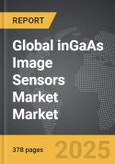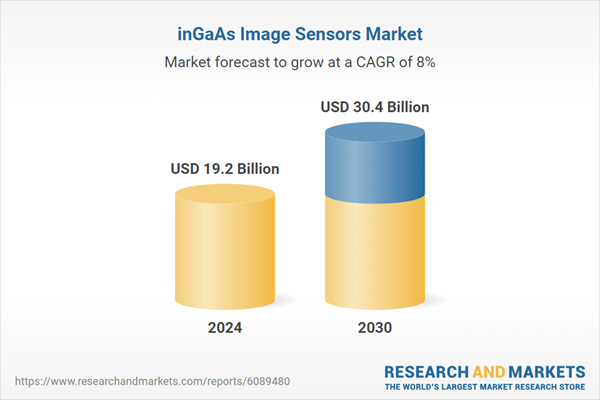Global InGaAs Image Sensors Market - Key Trends & Drivers Summarized
Why Are InGaAs Image Sensors Becoming Indispensable in Advanced Imaging Applications?
Indium Gallium Arsenide (InGaAs) image sensors have emerged as critical components in high-sensitivity imaging systems, especially for applications operating in the short-wave infrared (SWIR) spectrum. Unlike conventional silicon-based sensors, which are limited to visible light, InGaAs sensors can detect wavelengths from approximately 900 nm to 1700 nm, making them ideal for capturing thermal, night-time, or low-visibility imagery. This spectral range is essential in fields such as defense, aerospace, industrial inspection, medical diagnostics, and scientific research.The value of InGaAs sensors lies in their ability to visualize what the human eye or traditional imaging systems cannot see - detecting defects beneath surfaces, monitoring heat signatures, or capturing chemical compositions through spectral reflectance. These sensors are increasingly deployed in applications where accuracy, non-destructive analysis, and sensitivity to subtle thermal or moisture variations are critical. Their usage is growing in machine vision systems for quality control, semiconductor wafer inspection, and agricultural monitoring, where precise spectral imaging enables better decision-making and process optimization.
What Technological Advancements Are Enhancing InGaAs Sensor Performance?
InGaAs image sensors are benefiting from rapid innovation in semiconductor materials engineering, pixel miniaturization, and sensor architecture. One major trend is the development of higher-resolution focal plane arrays (FPAs), which allow for finer image detail and broader field-of-view coverage without compromising sensitivity. Manufacturers are now integrating advanced readout integrated circuits (ROICs) and on-chip analog-to-digital conversion to improve dynamic range, reduce noise, and enhance signal fidelity, even in low-light conditions.Backside illumination (BSI) techniques, wafer-level packaging, and hybrid bonding processes are enabling more compact and efficient sensor designs that are suitable for portable and space-constrained applications such as UAV payloads and wearable imaging systems. Furthermore, multispectral and hyperspectral InGaAs sensors are emerging, capable of capturing multiple narrow bands simultaneously - opening new opportunities in mineral analysis, vegetation monitoring, and biomedical imaging. Cooling technologies, such as thermoelectric cooling, are also being refined to further suppress dark current and enhance long-exposure performance.
Which Industries Are Driving the Adoption of InGaAs Image Sensors?
A diverse range of industries is accelerating the adoption of InGaAs image sensors, each with unique spectral imaging requirements. In the defense and aerospace sectors, these sensors are integrated into night vision goggles, surveillance systems, target acquisition devices, and missile guidance systems, where their ability to function in total darkness or smoke-filled environments offers significant tactical advantage. The semiconductor industry uses InGaAs-based inspection systems to detect micro-cracks, voids, or dopant variations in wafers and microchips - defects that are invisible in the visible light spectrum.In industrial automation and machine vision, InGaAs sensors play a vital role in identifying moisture intrusion, heat leaks, and material inconsistencies during production, especially in packaging, electronics, and solar panel manufacturing. Medical and life sciences applications are also emerging, particularly in near-infrared spectroscopy for tissue imaging, blood flow analysis, and pharmaceutical inspection. Agricultural and environmental monitoring solutions are increasingly deploying InGaAs sensors for detecting crop stress, water content, and soil composition from aerial platforms, providing valuable data for precision farming and sustainability initiatives.
The Growth in the InGaAs Image Sensors Market Is Driven by Several Factors…
The growth in the InGaAs image sensors market is driven by several factors including increasing demand for advanced spectral imaging, expanding deployment of machine vision systems, and technological progress in sensor fabrication. Rising global focus on automation, safety, and precision control is prompting industries to adopt sensors capable of delivering high-resolution images in low-light or non-visible wavelengths. As artificial intelligence and edge computing become integral to imaging systems, the need for high-fidelity, low-noise data input from SWIR-capable sensors is accelerating adoption in both defense and commercial sectors.Additionally, the miniaturization of InGaAs sensors and the reduction in manufacturing costs are making them more accessible to new markets, including consumer-level spectroscopy, mobile healthcare devices, and portable inspection tools. Regulatory emphasis on quality assurance, sustainability, and non-invasive diagnostics across sectors is also bolstering demand for high-sensitivity imaging. With ongoing innovation in hybrid imaging, multispectral detection, and integrated smart optics, InGaAs image sensors are positioned to play an increasingly vital role in the evolution of intelligent imaging systems worldwide.
Report Scope
The report analyzes the inGaAs Image Sensors market, presented in terms of market value (US$). The analysis covers the key segments and geographic regions outlined below:- Segments: Type (Linear Image Sensor, Area Image Sensor); Application (Industrial Measurement, Surveillance & Security, Optical Coherence Tomography, Laboratory Measurements, Other Applications); End-Use (Industrial Automation, Military & Defense, Food & Beverages, Transportation & Healthcare, Life Sciences, Other End-Uses).
- Geographic Regions/Countries: World; United States; Canada; Japan; China; Europe (France; Germany; Italy; United Kingdom; Spain; Russia; and Rest of Europe); Asia-Pacific (Australia; India; South Korea; and Rest of Asia-Pacific); Latin America (Argentina; Brazil; Mexico; and Rest of Latin America); Middle East (Iran; Israel; Saudi Arabia; United Arab Emirates; and Rest of Middle East); and Africa.
Key Insights:
- Market Growth: Understand the significant growth trajectory of the Linear Image Sensor segment, which is expected to reach US$21.8 Billion by 2030 with a CAGR of a 9.1%. The Area Image Sensor segment is also set to grow at 5.4% CAGR over the analysis period.
- Regional Analysis: Gain insights into the U.S. market, valued at $5.2 Billion in 2024, and China, forecasted to grow at an impressive 12.7% CAGR to reach $6.6 Billion by 2030. Discover growth trends in other key regions, including Japan, Canada, Germany, and the Asia-Pacific.
Why You Should Buy This Report:
- Detailed Market Analysis: Access a thorough analysis of the Global inGaAs Image Sensors Market, covering all major geographic regions and market segments.
- Competitive Insights: Get an overview of the competitive landscape, including the market presence of major players across different geographies.
- Future Trends and Drivers: Understand the key trends and drivers shaping the future of the Global inGaAs Image Sensors Market.
- Actionable Insights: Benefit from actionable insights that can help you identify new revenue opportunities and make strategic business decisions.
Key Questions Answered:
- How is the Global inGaAs Image Sensors Market expected to evolve by 2030?
- What are the main drivers and restraints affecting the market?
- Which market segments will grow the most over the forecast period?
- How will market shares for different regions and segments change by 2030?
- Who are the leading players in the market, and what are their prospects?
Report Features:
- Comprehensive Market Data: Independent analysis of annual sales and market forecasts in US$ Million from 2024 to 2030.
- In-Depth Regional Analysis: Detailed insights into key markets, including the U.S., China, Japan, Canada, Europe, Asia-Pacific, Latin America, Middle East, and Africa.
- Company Profiles: Coverage of players such as AirAsia Group, Airfree SAS, Anuvu, Capital A Berhad (AirAsia), Cathay Pacific Airways and more.
- Complimentary Updates: Receive free report updates for one year to keep you informed of the latest market developments.
Some of the 33 companies featured in this inGaAs Image Sensors market report include:
- Axiom Optics
- Chunghwa Leading Photonics Tech
- First Sensor AG
- FLIR Systems Inc.
- GHOPTO
- Hamamatsu Photonics K.K.
- Jenoptik AG
- Luna Innovations
- Lynred
- New Imaging Technologies
- Oxford Instruments
- Raptor Photonics
- SemiConductor Devices
- Sensors Unlimited Inc.
- Sofradir Group
- Sony Semiconductor Solutions
- Synergy Optosystems Co., Ltd.
- Teledyne Technologies Incorporated
- Xenics
- Zolix Instruments Co., Ltd.
This edition integrates the latest global trade and economic shifts into comprehensive market analysis. Key updates include:
- Tariff and Trade Impact: Insights into global tariff negotiations across 180+ countries, with analysis of supply chain turbulence, sourcing disruptions, and geographic realignment. Special focus on 2025 as a pivotal year for trade tensions, including updated perspectives on the Trump-era tariffs.
- Adjusted Forecasts and Analytics: Revised global and regional market forecasts through 2030, incorporating tariff effects, economic uncertainty, and structural changes in globalization. Includes historical analysis from 2015 to 2023.
- Strategic Market Dynamics: Evaluation of revised market prospects, regional outlooks, and key economic indicators such as population and urbanization trends.
- Innovation & Technology Trends: Latest developments in product and process innovation, emerging technologies, and key industry drivers shaping the competitive landscape.
- Competitive Intelligence: Updated global market share estimates for 2025, competitive positioning of major players (Strong/Active/Niche/Trivial), and refined focus on leading global brands and core players.
- Expert Insight & Commentary: Strategic analysis from economists, trade experts, and domain specialists to contextualize market shifts and identify emerging opportunities.
Table of Contents
Companies Mentioned (Partial List)
A selection of companies mentioned in this report includes, but is not limited to:
- Axiom Optics
- Chunghwa Leading Photonics Tech
- First Sensor AG
- FLIR Systems Inc.
- GHOPTO
- Hamamatsu Photonics K.K.
- Jenoptik AG
- Luna Innovations
- Lynred
- New Imaging Technologies
- Oxford Instruments
- Raptor Photonics
- SemiConductor Devices
- Sensors Unlimited Inc.
- Sofradir Group
- Sony Semiconductor Solutions
- Synergy Optosystems Co., Ltd.
- Teledyne Technologies Incorporated
- Xenics
- Zolix Instruments Co., Ltd.
Table Information
| Report Attribute | Details |
|---|---|
| No. of Pages | 378 |
| Published | December 2025 |
| Forecast Period | 2024 - 2030 |
| Estimated Market Value ( USD | $ 19.2 Billion |
| Forecasted Market Value ( USD | $ 30.4 Billion |
| Compound Annual Growth Rate | 8.0% |
| Regions Covered | Global |









